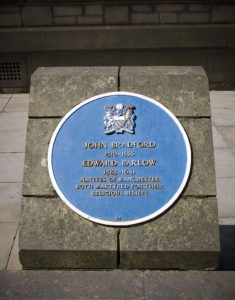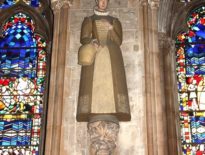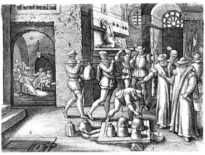
Plaque to Barlow and fellow martyr John Bradford outside Manchester Cathedral
The Barlow family had converted to Protestantism, but this conversion had been somewhat reluctant. Ambrose's grandfather had died in 1584 while imprisoned for his Catholic leanings, and his father had a large portion of his estate confiscated as a result of his initial refusal to conform to the new religion. On 30th November 1585, Ambrose was baptised, and following this, he adhered to the Anglican faith until 1607, after which he converted to Roman Catholicism.
In 1597, Ambrose was taken into Sir Uryan Legh's stewardship, where he served his apprenticeship as a page. However, perhaps this service cemented his conversion to Catholicism as he realised his true calling was the priesthood. He travelled to Douai in France to study and, following this, attended the Royal College of St Alban in Valladolid, Spain. After completing his studies in Spain, he returned to Douai in 1615 and became a member of the Order of St Benedict, joining the community of St Gregory the Great and was finally ordained as a priest in 1617.
Following his ordination, Ambrose returned to Barlow Hall and took up residency at Sir Thomas Tyldesley's house. Sir Thomas' grandmother arranged for a pension to be made available to Ambrose to enable him to carry out his priestly duties amongst the Catholics within his parish. Following this appointment, he catered for Catholic parishioners' needs secretly, offering daily Mass and reciting his Office and Rosary for nearly 24 years.
During these years, Ambrose was arrested four times, yet each time was released without charge. However, in 1641, Charles I signed a proclamation that declared that all priests should leave the country within a month or face being arrested and charged as traitors, which of course would result in imprisonment and/or death. It is believed that Ambrose's parishioners begged him to flee or at least go into hiding, but he refused. By this time, it is believed he had had a stroke which resulted in Ambrose being partially paralysed; this perhaps influenced his decision not to flee. This decision would prove fatal as, on 25th April 1641, Ambrose and his whole congregation were surrounded by the vicar of Leigh and armed men numbering around 400. Ambrose surrendered, and his parishioners were released, having given their names to the authorities. Ambrose, however, was arrested and taken to Lancaster Castle.
Ambrose appeared before the judge on 7th September and professed his Catholicism, and attempted to defend his actions. On 8th September, the judge, Sir Robert Heath, found Ambrose guilty and sentenced him to death. Two days later, he was escorted from Lancaster Castle and taken to the place of execution. Ambrose was hanged, quartered and boiled in oil. Following this, his head was placed on a pike.
Pope Paul VI canonised ambrose on 25th October 1970.
by Georgia Whitehead
Georgia has just finished her masters in Classics at the University of Edinburgh. Academically, Georgia is interested in early Christianity, with her master's thesis focusing on "The Male Gaze and Self-Representation in Female Christian Narratives". In addition to her interest in ancient history, she has always been an avid lover of the Tudor era, drawn to the magnificence of the Tudor courts and the larger than life characters. She is particularly interested in The Reformation, Christianity and the shifting sands of ecclesiastical politics in this period and also has a keen interest in the lives of Tudor women. It is Georgia's ambition to become a writer, perhaps publishing her own Tudor novel one day.
Georgia also runs a history blog and instagram page called Historia Mundis.



Leave a Reply